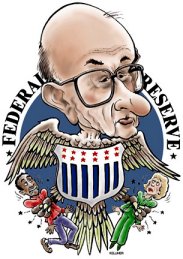
The Structure of the Fed
 Contents
Contents |
Next 
|
|
 |
The Federal Reserve System is
an odd beast: a public/private mix "deliberately set apart from elected
government, yet part of it," as author William Greider wrote in Secrets
of the Temple.
Inside this peculiar structure, blessed and overseen by
the government, private banks wield great leverage and enjoy a remarkable
degree of special access.
The Fed is directed by a seven-member Board of Governors.
The Governors (including the Chairman) are appointed by the President and
confirmed by the Senate.
The Federal Reserve System is divided into 12 regional
Federal Reserve Districts, each headed by a nine-member Board of Directors.
Two-thirds of the directors are elected by the 3,296 private commercial
banks (the "Member Banks") belonging to the Federal Reserve System. The
remainder are appointed by the Board of Governors. Each district board
elects its own Reserve Bank President, subject to the approval of the Board
of Governors.
The powerful Federal Open Market Committee consists of
12 people: the seven Governors and five of the 12 district presidents,
who serve on a rotating basis.
The influential Federal Advisory Committee (which meets
four times a year, in private, to advise the BOG) is elected by the 12
Reserve Bank Boards. District directors also meet 24 times a year and (among
other business) vote to urge the Board of Governors to raise, lower or
maintain interest rates. |